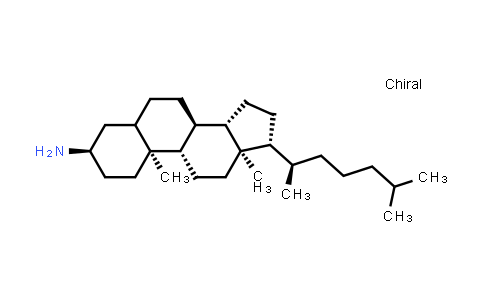
3α-Aminocholestane NLT 98%
Product Number : MC541665
CAS Number : 2206-20-4
Molecular Formula : C27H49N | Molecular Weight : 387.68
Quote Request| Purity | NLT 98% |
|---|---|
| Storage | at 20ºC 2 years |
| MolCore specializes in manufacturing high-purity CAS No.2206-20-4, 3α-Aminocholestane with the molecular formula C27H49N and molecular weight 387.68 delivering critical API intermediates for global pharmaceutical and research industries, certified under ISO quality systems. | |
* The above information is for reference only.
| Chemical Name | 3α-Aminocholestane |
|---|---|
| CAS Number | 2206-20-4 |
| Molecular Formula | C27H49N |
| Molecular Weight | 387.68 |
3α-Aminocholestane is a selective SH2 domain-containing inositol-5′-phosphatase 1 (SHIP1) inhibitor with an IC50 of ~2.5 μM. IC50 & Target: IC50: 2.5 μM (SHIP1)[1] In Vitro: OPM2 cell viability is effectively reduced by 3α-Aminocholestane (3AC) treatment. RPMI8226 and U266 cells show significantly less sensitivity to 3α-Aminocholestane treatment when compare with OPM2 cells, although viability is decreased significantly at concentrations of ≥12.5 μM. Treatment with 3α-Aminocholestane for 36 h severely reduces the percentage of cells in the S phase, which is accompanied by an increase of cells in the G2/M phase. In contrast, in the less proliferative RPMI8226 and U266 cells, cell cycle progression is blocked in the G0/G1 phase upon 3α-Aminocholestane treatment, in conjunction with a reduced percentage of cells undergoing the S phase[2]. In Vivo: It is found that 3α-Aminocholestane (3AC) results in reduced multiple myeloma (MM) growth in vivo, as determined by quantitation of free human Igλ light chain in the plasma after OPM2 challenge. In addition, reduced numbers of circulating OPM2 cells, as determined by human HLA-ABC staining, is observed in peripheral blood from 3α-Aminocholestane-treated mice compare with vehicle controls. Most importantly, 3α-Aminocholestane treatment results in significantly enhanced survival of mice after tumor challenge. In 3α-Aminocholestane-treated mice that resist treatment, it is found that MM tumors exhibit an upregulation of SHIP2, reminiscent of in vitro treatment of OPM2 cells and suggesting that SHIP1 inhibition may select for tumor cells with increased SHIP2 expression[2].
© Copyright 2015-2025 Hangzhou MolCore BioPharmatech Co.,Ltd. All rights reserved.
